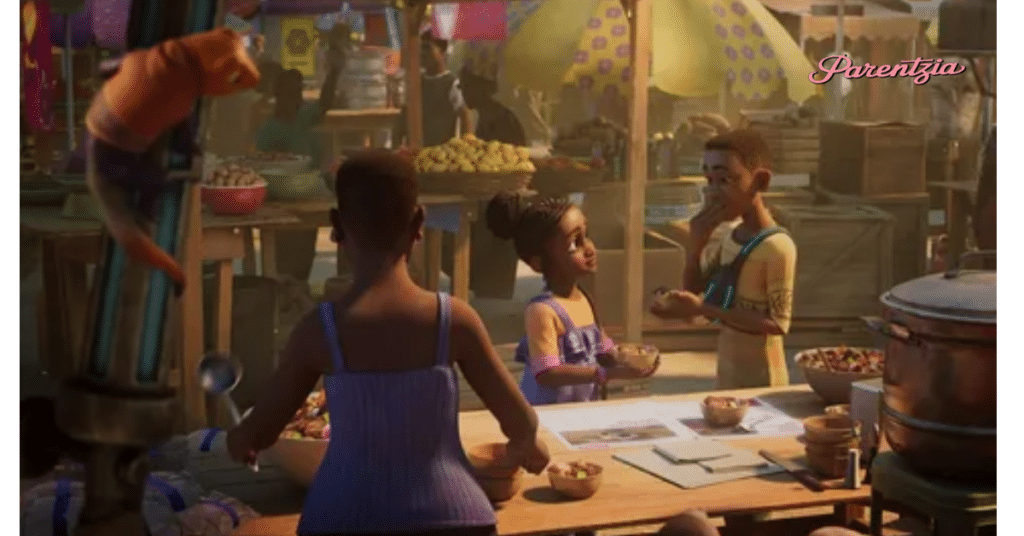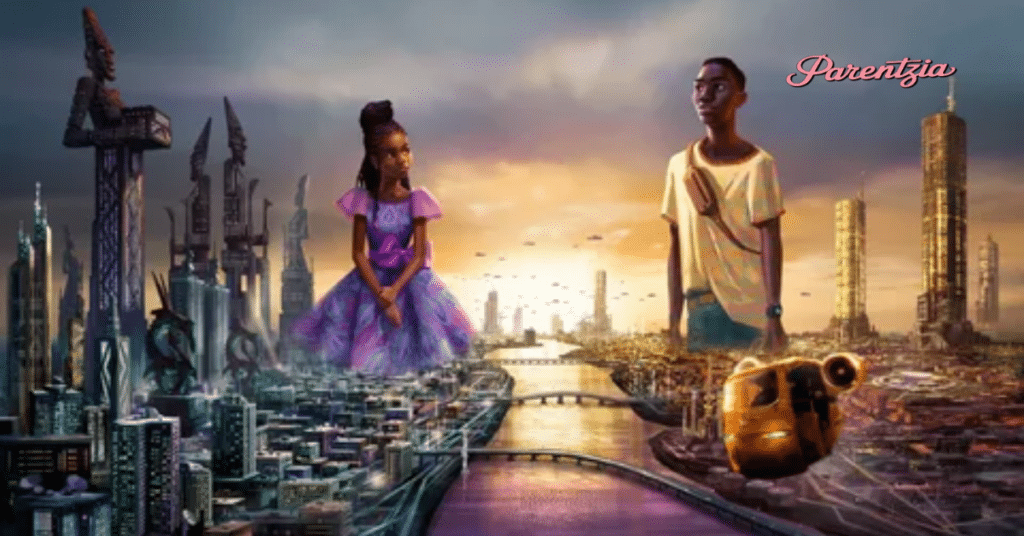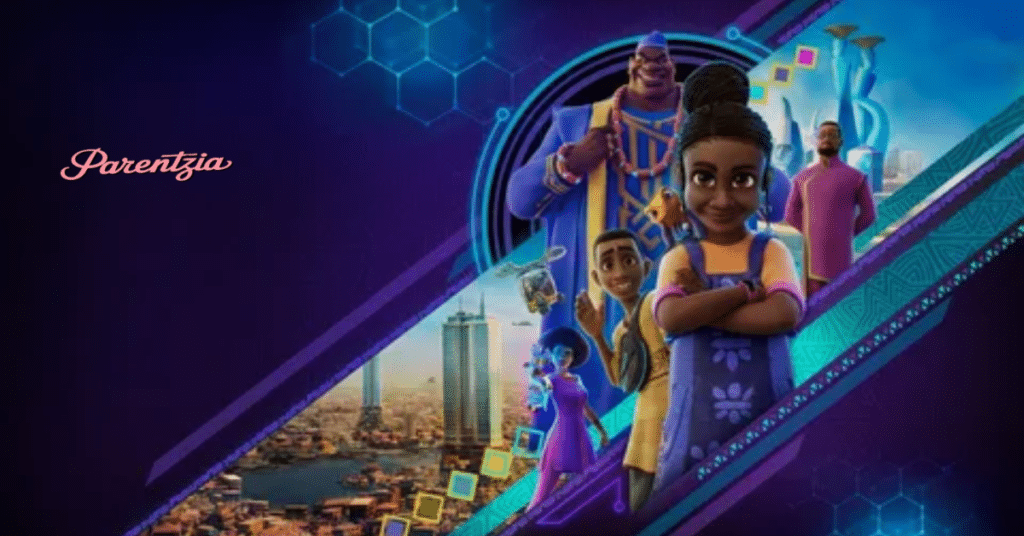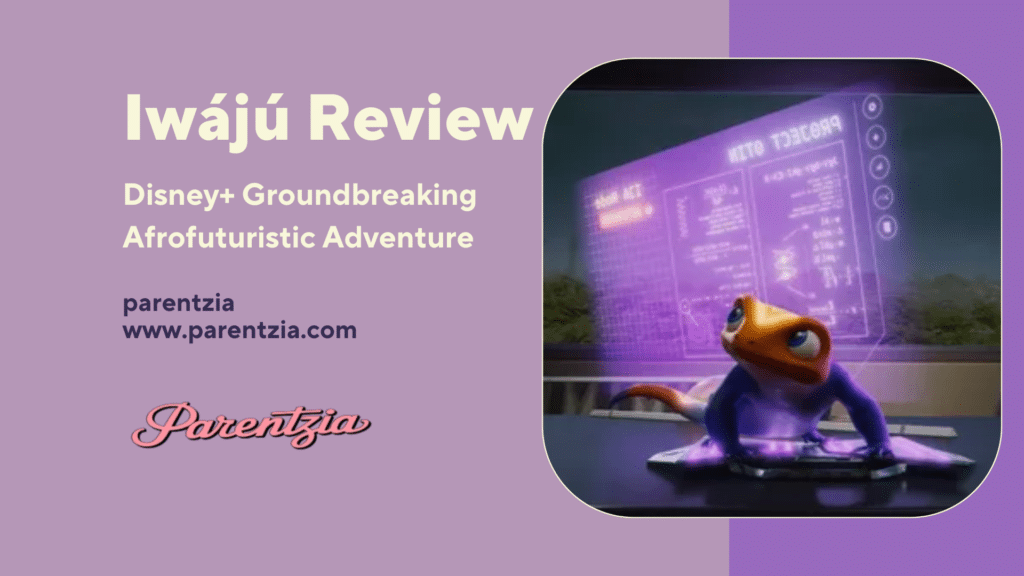In the ever-expanding universe of animated television series, Disney+ has just dropped a gem that’s got everyone talking. Iwájú, the streaming giant’s latest offering, isn’t just another cartoon – it’s a bold leap into the future of storytelling. This Disney+ original series, born from a collaboration with African entertainment company Kugali, brings to life a futuristic African comic that’s as visually stunning as it is thought-provoking. But is it safe for kids? Let’s dive into this Iwájú review and explore every nook and cranny of this groundbreaking show.
A Dazzling Dive into Iwájú’s Afrofuturistic World
Iwájú doesn’t just invite you to watch – it catapults you into a Lagos you’ve never seen before. This isn’t your grandpa’s Nigeria; it’s a jaw-dropping blend of traditional African aesthetics and cutting-edge technology. Imagine floating skyscrapers kissing the clouds, while down below, bustling markets burst with color and life. It’s a world where holograms dance alongside street vendors, and flying cars zip past ancient temples.
But Iwájú’s Lagos isn’t just eye candy. The show’s creators have crafted a setting that feels lived-in and real, despite its fantastical elements. You can almost smell the jollof rice simmering in high-tech food stalls and hear the mix of pidgin English and Yoruba floating on the breeze.

“We wanted to create a world that African kids could see themselves in, but also one that would captivate audiences worldwide,” says Ziki Nelson, one of Kugali’s co-founders.
This attention to detail pays off in spades. Iwájú’s Lagos becomes a character in its own right, one that will have viewers pausing and rewinding just to catch all the little details hidden in every frame.
You might also like “Little Wing 2024 Movie Review: A Heartfelt journey”
Meet the Dynamic Duo: Tola and Kole
At the heart of Iwájú’s story are two kids who couldn’t be more different – or more perfectly matched. Tola, voiced by the talented Simisola Gbadamosi, is a tech-savvy rich girl with a rebellious streak a mile wide. She’s got all the gadgets money can buy, but what she really craves is freedom from her overprotective family.
Then there’s Kole, a scrappy self-taught tech whiz from the city’s poorer mainland. He’s got more street smarts in his little finger than most adults have in their whole body, but he’s also got a heart of gold that often gets him into trouble.
When these two cross paths, it’s like watching fireworks go off. Their unlikely friendship forms the backbone of the series, tackling themes of class divide, privilege, and the true meaning of family in ways that’ll resonate with viewers young and old.
Character Spotlight: Tola and Kole
| Character | Tola | Kole |
| Background | Wealthy island resident | Working-class mainlander |
| Skills | Access to cutting-edge tech | Self-taught engineering genius |
| Personality | Adventurous, sheltered | Street-smart, compassionate |
| Dream | To explore beyond her gilded cage | To use tech to improve his community |
Iwájú’s Stunning Visuals: A Feast for the Eyes
Let’s talk eye candy, folks. Iwájú’s animation is nothing short of revolutionary. The show blends 2D and 3D elements in a way that feels fresh and exciting, with a color palette that pops right off the screen. From the neon-lit streets of Lagos Island to the gritty, lived-in feel of the mainland, every frame is a work of art.
But it’s not just about looking pretty. The animation team has gone above and beyond to infuse every scene with little details that bring this world to life. Keep your eyes peeled for:
- Afrofuturistic fashion that blends traditional Nigerian clothing with sci-fi flair
- Clever visual gags hidden in background signage
- Subtle nods to real Lagos landmarks reimagined for the future

And let’s not forget the character designs. Tola and Kole are expressive and instantly lovable, but it’s the supporting cast and background characters that really show off the animators’ skills. From wise old aunties to mischievous street kids, every character feels unique and full of life.
Sounds of the Future: Iwájú’s Sonic Landscape
A feast for the eyes deserves a banquet for the ears, and Iwájú delivers in spades. The show’s soundtrack is a pulsing blend of Afrobeats, electronic music, and traditional Nigerian sounds that’ll have you bobbing your head long after the credits roll. It’s the kind of music that doesn’t just complement the action – it drives it forward, ramping up the energy in chase scenes and tugging at your heartstrings during quieter moments.
But the real star of the audio show is the voice acting. Simisola Gbadamosi brings Tola to life with a perfect mix of youthful energy and hidden vulnerability. The rest of the cast is equally stellar, with performances that nail the nuances of Nigerian speech patterns and accents. It’s a level of authenticity that’s too often missing in animated shows set outside the West.
Themes That’ll Make You Think
Don’t let the gorgeous visuals fool you – Iwájú’s got some serious meat on its bones when it comes to themes. At its core, this is a story about the haves and have-nots, set against the backdrop of a rapidly changing world. The show doesn’t shy away from tough questions:
- How do we balance progress with preserving cultural heritage?
- What responsibilities do the wealthy have to their less fortunate neighbors?
- Can technology bridge the gap between social classes, or does it just widen it?
These aren’t easy topics, but Iwájú handles them with a deft touch that never feels preachy. Instead, it lets its characters and their actions do the talking, trusting viewers to draw their own conclusions.
One particularly powerful storyline explores the environmental impact of unchecked technological growth. It’s a theme that’s relevant worldwide but hits especially hard in the context of a developing nation like Nigeria.
Behind the Scenes: The Minds That Made Iwájú
The story of how Iwájú came to be is almost as fascinating as the show itself. It all started when Disney executives stumbled upon the work of Kugali, a pan-African entertainment company founded by three friends with a passion for telling African stories.
What followed was a groundbreaking collaboration that brought together the best of both worlds:
- Disney’s unparalleled resources and animation expertise
- Kugali’s deep understanding of African culture and storytelling traditions
The result is a show that feels authentically Nigerian while still hitting those high notes of quality we’ve come to expect from Disney. It’s a model that could pave the way for more diverse voices in mainstream animation.
“Working with Disney has been surreal,” says Tolu Olowofoyeku, another Kugali co-founder. “They’ve given us the freedom to tell our story our way, while providing the support to make it truly world-class.”
Iwájú’s Place in the Animation Landscape
So how does Iwájú stack up against other heavy hitters in the world of animation? Pretty darn well, if you ask me. While it’s got that unmistakable Disney polish, it’s not afraid to push boundaries in ways that more established franchises might shy away from.

Compared to other Disney+ originals, Iwájú stands out for its:
- Unapologetically Afrocentric setting and themes
- Willingness to tackle complex social issues
- Innovative blend of 2D and 3D animation techniques
It’s a show that could easily hold its own against acclaimed series like “Avatar: The Last Airbender” or “The Dragon Prince” in terms of world-building and character development.
The Good, The Bad, and The Robot Lizard
No show’s perfect, so let’s break down what works and what might need a little tweaking:
The Good:
- Breathtaking visuals that set a new standard for TV animation
- Complex, relatable characters that grow and evolve
- A rich, fully-realized world that begs to be explored
- Thoughtful handling of mature themes
The Could-Be-Better:
- Some secondary characters feel underdeveloped
- A few plot points rely a bit too heavily on convenient coincidences
- The pacing can feel rushed in later episodes
And then there’s the robot lizard. This little scene-stealer is either going to be your favorite part of the show or a bit of comic relief that falls flat, depending on your taste. Personally, I’m Team Lizard all the way.
Who’s This Show For, Anyway?
Here’s the million-naira question: is Iwájú safe for kids? The show carries a TV-PG rating, which means parental guidance is suggested. Let’s break down that TV-PG rating:
- Violence: Mostly cartoonish, but some intense action scenes
- Language: Mild swearing, nothing you wouldn’t hear on the playground
- Themes: Some complex topics that might go over younger kids’ heads
For a more detailed parents guide, consider this:
- Ages 7-9: Might enjoy the adventure and visuals, but may need help understanding some plot points
- Ages 10-12: Sweet spot – old enough to follow the story, young enough to be wowed by the world
- Teens and up: Will appreciate the deeper themes and social commentary
Ultimately, Iwájú is that rare beast – a family-friendly show that doesn’t talk down to its audience. It’s got enough action and humor to keep the kids entertained, while offering plenty of food for thought for older viewers.
The Bigger Picture: Iwájú’s Cultural Impact
Iwájú isn’t just a TV show – it’s a cultural milestone. In a media landscape that’s still dominated by Western perspectives, this Disney+ original series is a breath of fresh air. It’s representation done right, showcasing African culture, creativity, and innovation in a way that feels authentic and respectful.

The impact of this can’t be overstated. For African kids, it’s a chance to see themselves as the heroes of their own stories. For viewers around the world, it’s an invitation to see Africa not as a monolith of poverty and strife, but as a vibrant, diverse continent brimming with potential.
Stream or Pass? The Verdict
After diving deep into the world of Iwájú, I can confidently say: this show is a must-watch. It’s visually stunning, emotionally resonant, and intellectually stimulating in a way that few animated series manage to achieve. The six-episode first season flies by, leaving you hungry for more.
Is it perfect? No. But its flaws are far outweighed by its strengths. Iwájú is the kind of show that sticks with you, sparking conversations and firing up the imagination long after the credits roll.
So gather the family, fire up Disney+, and get ready for an adventure unlike any other. Iwájú isn’t just the future of African animation – it might just be the future of animation, period.

Tina Grey is an experienced blogger with a passion for uncovering the best in film. With years of writing and a keen eye for detail, Tina brings insightful reviews and engaging content to Parentzia. Her deep love for movies, combined with her expertise, helps readers discover must-watch films across genres. When she’s not reviewing, Tina enjoys exploring new cinematic trends and sharing her love of film with her audience.







